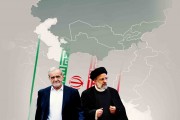Publish Date
Sunday 28 May 2023 - 11:51
recommended
0
Turkey’s role and position in Energy Geopolitics of Central Asia
In recent years, Turkey has had a specific view on playing a strategic role in the geo-economic fields of Central Asia. During the past year, these efforts have been more pragmatic than ever, and have achieved more favorable results. Turkey has used the crisis in Ukraine in the best possible way to promote geo-economic projects in energy sector.
By: Central Asia working group of IESS
Introduction
In recent years, Turkey has turned into one of the influential players in Central Asia, after Russia and China. The development of political-security relations, along with the strengthening of trade exchanges, has made this country one of the main partners of Central Asian republics. Trade exchanges between Turkey and five Central Asian republics in the first 11 months of 2022 amounted to 11 billion dollars, which shows the high level of these relations. This issue, along with Turkey's relative successes in the Caucasus, has led to the country's approach to Central Asia being upgraded and extended to the geopolitical sphere. However, it seems that this country still lacks the necessary resources to deal with Russia's hegemony or China's influence in the region. So, by considering its position in relations with the West, Turkey seems to be focused on the geo-economic sphere. The two areas of transit and energy have been the main focuses of Turkey's strategic plan for Central Asia. In transit sphere, the 300% growth in the Middle Corridor after the war in Ukraine, and the special focus of Turkey to invest in logistics infrastructure to connect Central Asia and the Caucasus, are clearly visible. However, in energy sector, it seems that Turkey is still in the first steps and has less chance to compete with Russia, China and Iran. In this report, we try to examine the key axes of Turkey's strategic movements in energy sector, and to examine the role and position of this country in the energy geopolitics of Central Asia.
Becoming a gas hub
Central Asian countries are among the countries with rich gas resources. According to the latest report of British Petroleum (BP), the total natural gas extraction in Turkmenistan was 79.3 billion cubic meters (bcm), Uzbekistan 50.9 bcm and Kazakhstan 32 bcm. This shows that the three Central Asian republics have extracted a total of 162 bcm of gas, which is close to the volume of gas produced by Qatar (177 bcm). Therefore, if these resources are aggregated, they can play a significant role in the global gas market. Also, this figure is a significant level compared to the export of 100 bcm of Russian gas to Europe. In addition to this issue, it is necessary to pay attention to the unique volume of proven reserves of these countries, which in case of investment, provides more production capability for these countries. However, due to the difficulty in gas transportation and lack of internal consumption, this capacity has not been developed in petrochemical production units. The key priority of these countries for investing in natural gas sector, has been Alterant Industries.
The gas crisis in Europe after the war in Ukraine and, at the same time, the U.S withdrawal from Afghanistan and the uncertainty in the future of TAPI (Turkmenistan–Afghanistan–Pakistan–India gas pipeline), seem to have changed the strategic plans of Central Asia. Currently, these countries have the greatest chance to construct infrastructures related to gas transmission to western regions and gas export to Europe. This is exactly the point that Turkey is focused on. Currently, there are necessary infrastructures to transfer gas from the Republic of Azerbaijan to Europe. The gas produced in Azerbaijan currently reaches Turkey through the South Caucasus Pipeline, and from there it is injected into the Trans-Adriatic Pipeline (TAP) at the borders of Europe, through the Trans-Anatolian Pipeline. The current capacity of the South Caucasus Pipeline is about 25 bcm per year, and currently the Republic of Azerbaijan is not able to provide the full capacity of this pipeline. Azerbaijan's total gas production in 2021 was only 31 bcm, of which 12.7 bcm was consumed domestically and about 18 bcm has an export capacity. In 2021, less than 9 bcm of this amount was able to be exported to Europe, and an important part of this country's exports was focused on Georgia and Turkey’s markets. According to the Memorandum of Understanding (MoU) on a Strategic Partnership that signed between Europe and Azerbaijan last year, it has been predicted that this figure would reach 12 bcm in 2022, and the vision for 2027 is about 20 bcm – a figure which is not practically possible, considering Azerbaijan's current gas reserves.
The only short-term solution to achieve these goals is to use the Central Asia gas resources. Two republics of Uzbekistan and Kazakhstan have joined an informal gas alliance with Russia due to the growing trend of domestic consumption and especially the lack of gas in winter, and they are practically unable to export gas to Europe, because of their geographical location. However, Turkmenistan is a country that has a significant capacity for this. Turkey is an actor that is trying to achieve this goal. In the first place, Turkey seems to focus on quick-yielding and income-generating solutions to provide the necessary investment for the development of joint projects. In the tripartite meeting in Avaza, Turkmenistan, with the presence of Turkmenistan and Azerbaijan presidents, Recep Tayyip Erdoğan stated that various methods are considered for the transfer of gas from Turkmenistan to Azerbaijan. Although it has not been officially announced yet, it seems that the use of CNG carrier ships are one of Turkey's short-term solutions to play this role. By using a few small ship, it is expected a volume of about 3 bcm of gas will be able to be transferred from Baku to Europe annually.
Turkey's medium-term plan is to develop the Dostluk Field, with the investment of Azerbaijan and European partners. In a historical agreement between Azerbaijan and Turkmenistan, the field was named as this, and it seems that the disputes surrounding it have been resolved. Turkmenistan will probably not oppose it, if Azerbaijan, Turkey and Europe invest in the development of the field, and the country can have income sources from its oil and gas exports. Initial estimates indicate that this field has about 100 bcm of gas reserves, and if the extraction infrastructure is developed, it will have the capability to inject about 5 bcm of gas annually into the South Caucasus Pipeline. This field is also located in the middle of the Caspian Sea and is closer to the shores of Baku, and the construction of the pipeline there is less expensive and faces fewer challenges compared to the Trans-Caspian Gas Pipeline. At the same time, the export revenues from the development of this field, both in gas and oil sectors (with an approximate estimate of 60 million tons of oil), create many possibilities for the development of the Trans-Caspian Pipeline from Turkmenbashi to the Dostluk Field. From this perspective, Turkey will gradually develop the Trans-Caspian Pipeline, with an operational capacity of 10 bcm a year, in a multi-stage program. Of course, Turkey's plan to develop this pipeline is to transfer 30 bcm of gas per year, which currently seems far from reality.
Entering the oil export sphere
Exporting Central Asian oil to Europe is a new sphere that Turkey has been paying attention to after the Ukraine war. Among the Central Asian countries, Kazakhstan is the largest oil producer. According to BP's 2022 report, which is based on 2021 data, Kazakhstan's total oil production this year was 1.811 million barrels per day. Meanwhile, the oil production of Turkmenistan and Uzbekistan was 252,000 and 60,000 barrels respectively, which is a very limited figure compared to the Kazakhstan’s production. Even with this limited production, however, Turkey and the West have had a relatively successful experience in exporting Central Asian oil in the past. Before this, the oil extracted in Turkmenistan was exported through swaps with Iran and some other methods. But with development of the role and influence of Dragon Oil company of the United Arab Emirates in the oil infrastructure of Turkmenistan and imposing sanctions against the Islamic Republic of Iran, this oil was sent to Baku through tankers, and then exported to other destinations through the Baku-Tbilisi-Ceyhan pipeline. Now, with sanctions on Russia and similar problems arising for Kazakhstan, Turkey seems to be trying to play a similar role. Albeit, after the interruptions caused by Russia in oil exports, Kazakhstan's strategic attitude has also turned towards alternative routes and diversification of energy export corridors.
However, regarding Kazakhstani oil, the existing infrastructure in the Baku-Tbilisi-Ceyhan pipeline is still very limited. The vision drawn up by the Kazakh government for the transportation of oil through the Caspian Sea and the Baku-Tbilisi-Ceyhan pipeline is 1.5 million tons. This figure is very small compared to the oil production of 86 million tons by this country, and its share is about 1.74%. However, preliminary estimates indicate that this vision cannot also be realized for 2023. Some disruptions in the transportation of oil from Aktau port to Baku, and restrictions on oil loading and unloading, along with the limited oil shipping of Caspian Sea, have brought the initial estimates to the figure of 1.15 million tons for 2023, which includes 1.33% of Kazakhstan's oil. Although this figure is still very limited and small in the scale of Kazakhstan's oil exports, it is a relative success for Turkey.
Meanwile, three other trends have been happening this year that can limit Turkey's capacities. First, Kazakhstan's oil export capacity from Aktau to the Makhachkala port in Russia has also increased through the Caspian Sea. The export of 2.3 million tons of oil to this port, compared to 109,000 tons to Baku, shows clearly the difference between these two routes. Second, with Russia's green light, Kazakhstan was able to reach an agreement with Germany for the export of 1.5 million tons of oil. It which can lead to a kind of return to Russia's path for Astana. The third factor is alternative land routes for oil export. According to published reports, out of a total of 1.8 million tons of oil exported by Kazakhstan bypassing Russia, 1.26 million tons were just exported to China, and routes like Uzbekistan have also been attractive for Kazakhstan.
Conclusion: The future perspective
In recent years, Turkey has had a specific view on playing a strategic role in the geo-economic fields of Central Asia. During the past year, these efforts have been more pragmatic than ever and have achieved more favorable results. Turkey has used the crisis in Ukraine in the best possible way to promote geo-economic projects in energy sector.
In gas sector, it seems that this country will finally be able to obtain a limited share of Turkmenistan's gas to complete the capacity of the South Caucasus gas pipeline. In the long term, however, increasing this share and playing a role requires investing in the Caucasus, and entering the more complex issues of the Caspian Sea. A further change in the geopolitical balance of the South Caucasus is a stimulus that can accelerate and facilitate this issue.
However, Russia's strategic view on the southern routes of gas export, and the formation of the Central Asian Gas Union is a parallel strategy that can greatly limit these plans of Turkey. Russia has seriously considered the issue of participation in TAPI. If Russia diverts its gas resources to the southern routes for the markets of Pakistan and India, the priorities regarding Turkmenistan will naturally change as well. Iran's pragmatic type of acting, especially in energy swap projects, will also be a determining factor in this sphere. If the Islamic Republic of Iran is able to transfer a larger share of Turkmenistan's gas to Azerbaijan through a swap (up to 5 bcm in the first phase, and then targeting 10 bcm), it can play an effective role in limiting Turkey's ideas. However, Turkey's relative success in the Dostluk Field will probably be inevitable, if the current political trends between Azerbaijan and Turkmenistan continue and if there is no security intervention by Iran and Russia.
In oil sector, it seems that Turkey’s task is more difficult. This country can hardly transport about one percent of Kazakhstan's oil. A significant part of Kazakhstan's oil sent to Baku-Tbilisi-Ceyhan is transported to Batumi port in Georgia, and only a limited share goes to Turkey. At the same time, the infrastructure for loading oil in the Caspian Sea and transporting it to Baku, along with the limited capacity of Baku-Tbilisi-Ceyhan, does not allow Turkey to play a more effective role.
However, oil sector, unlike gas, is a sphere that requires less investment for transportation, and its return on capital is faster due to the higher price and larger volume of available capacities. Therefore, if Turkey focuses on this sector, it seems that there is no serious obstacle for the current development. Especially, the European customers of Kazakh oil will need to buy more oil from this country instead of Russia, in order to create stability in the global oil market.
Nevertheless, in this sphere, the Islamic Republic of Iran is also considered a potential competitor for Turkey and an important alternative for the Baku route. Currently, there is oil loading infrastructure in Neka, Iran, and there was also an oil swap agreement and experience between Iran and Kazakhstan since past. This capacity can also be developed if the Islamic Republic of Iran is more pragmatic, and it can naturally limit the role and position of Turkey in the geopolitics of Central Asian energy. At the same time, diversifying the export routes and developing the oil export capacity through the Caspian Sea, are among the strategic goals of Kazakhstan.
Introduction
In recent years, Turkey has turned into one of the influential players in Central Asia, after Russia and China. The development of political-security relations, along with the strengthening of trade exchanges, has made this country one of the main partners of Central Asian republics. Trade exchanges between Turkey and five Central Asian republics in the first 11 months of 2022 amounted to 11 billion dollars, which shows the high level of these relations. This issue, along with Turkey's relative successes in the Caucasus, has led to the country's approach to Central Asia being upgraded and extended to the geopolitical sphere. However, it seems that this country still lacks the necessary resources to deal with Russia's hegemony or China's influence in the region. So, by considering its position in relations with the West, Turkey seems to be focused on the geo-economic sphere. The two areas of transit and energy have been the main focuses of Turkey's strategic plan for Central Asia. In transit sphere, the 300% growth in the Middle Corridor after the war in Ukraine, and the special focus of Turkey to invest in logistics infrastructure to connect Central Asia and the Caucasus, are clearly visible. However, in energy sector, it seems that Turkey is still in the first steps and has less chance to compete with Russia, China and Iran. In this report, we try to examine the key axes of Turkey's strategic movements in energy sector, and to examine the role and position of this country in the energy geopolitics of Central Asia.
Becoming a gas hub
Central Asian countries are among the countries with rich gas resources. According to the latest report of British Petroleum (BP), the total natural gas extraction in Turkmenistan was 79.3 billion cubic meters (bcm), Uzbekistan 50.9 bcm and Kazakhstan 32 bcm. This shows that the three Central Asian republics have extracted a total of 162 bcm of gas, which is close to the volume of gas produced by Qatar (177 bcm). Therefore, if these resources are aggregated, they can play a significant role in the global gas market. Also, this figure is a significant level compared to the export of 100 bcm of Russian gas to Europe. In addition to this issue, it is necessary to pay attention to the unique volume of proven reserves of these countries, which in case of investment, provides more production capability for these countries. However, due to the difficulty in gas transportation and lack of internal consumption, this capacity has not been developed in petrochemical production units. The key priority of these countries for investing in natural gas sector, has been Alterant Industries.
The gas crisis in Europe after the war in Ukraine and, at the same time, the U.S withdrawal from Afghanistan and the uncertainty in the future of TAPI (Turkmenistan–Afghanistan–Pakistan–India gas pipeline), seem to have changed the strategic plans of Central Asia. Currently, these countries have the greatest chance to construct infrastructures related to gas transmission to western regions and gas export to Europe. This is exactly the point that Turkey is focused on. Currently, there are necessary infrastructures to transfer gas from the Republic of Azerbaijan to Europe. The gas produced in Azerbaijan currently reaches Turkey through the South Caucasus Pipeline, and from there it is injected into the Trans-Adriatic Pipeline (TAP) at the borders of Europe, through the Trans-Anatolian Pipeline. The current capacity of the South Caucasus Pipeline is about 25 bcm per year, and currently the Republic of Azerbaijan is not able to provide the full capacity of this pipeline. Azerbaijan's total gas production in 2021 was only 31 bcm, of which 12.7 bcm was consumed domestically and about 18 bcm has an export capacity. In 2021, less than 9 bcm of this amount was able to be exported to Europe, and an important part of this country's exports was focused on Georgia and Turkey’s markets. According to the Memorandum of Understanding (MoU) on a Strategic Partnership that signed between Europe and Azerbaijan last year, it has been predicted that this figure would reach 12 bcm in 2022, and the vision for 2027 is about 20 bcm – a figure which is not practically possible, considering Azerbaijan's current gas reserves.
The only short-term solution to achieve these goals is to use the Central Asia gas resources. Two republics of Uzbekistan and Kazakhstan have joined an informal gas alliance with Russia due to the growing trend of domestic consumption and especially the lack of gas in winter, and they are practically unable to export gas to Europe, because of their geographical location. However, Turkmenistan is a country that has a significant capacity for this. Turkey is an actor that is trying to achieve this goal. In the first place, Turkey seems to focus on quick-yielding and income-generating solutions to provide the necessary investment for the development of joint projects. In the tripartite meeting in Avaza, Turkmenistan, with the presence of Turkmenistan and Azerbaijan presidents, Recep Tayyip Erdoğan stated that various methods are considered for the transfer of gas from Turkmenistan to Azerbaijan. Although it has not been officially announced yet, it seems that the use of CNG carrier ships are one of Turkey's short-term solutions to play this role. By using a few small ship, it is expected a volume of about 3 bcm of gas will be able to be transferred from Baku to Europe annually.
Turkey's medium-term plan is to develop the Dostluk Field, with the investment of Azerbaijan and European partners. In a historical agreement between Azerbaijan and Turkmenistan, the field was named as this, and it seems that the disputes surrounding it have been resolved. Turkmenistan will probably not oppose it, if Azerbaijan, Turkey and Europe invest in the development of the field, and the country can have income sources from its oil and gas exports. Initial estimates indicate that this field has about 100 bcm of gas reserves, and if the extraction infrastructure is developed, it will have the capability to inject about 5 bcm of gas annually into the South Caucasus Pipeline. This field is also located in the middle of the Caspian Sea and is closer to the shores of Baku, and the construction of the pipeline there is less expensive and faces fewer challenges compared to the Trans-Caspian Gas Pipeline. At the same time, the export revenues from the development of this field, both in gas and oil sectors (with an approximate estimate of 60 million tons of oil), create many possibilities for the development of the Trans-Caspian Pipeline from Turkmenbashi to the Dostluk Field. From this perspective, Turkey will gradually develop the Trans-Caspian Pipeline, with an operational capacity of 10 bcm a year, in a multi-stage program. Of course, Turkey's plan to develop this pipeline is to transfer 30 bcm of gas per year, which currently seems far from reality.
Entering the oil export sphere
Exporting Central Asian oil to Europe is a new sphere that Turkey has been paying attention to after the Ukraine war. Among the Central Asian countries, Kazakhstan is the largest oil producer. According to BP's 2022 report, which is based on 2021 data, Kazakhstan's total oil production this year was 1.811 million barrels per day. Meanwhile, the oil production of Turkmenistan and Uzbekistan was 252,000 and 60,000 barrels respectively, which is a very limited figure compared to the Kazakhstan’s production. Even with this limited production, however, Turkey and the West have had a relatively successful experience in exporting Central Asian oil in the past. Before this, the oil extracted in Turkmenistan was exported through swaps with Iran and some other methods. But with development of the role and influence of Dragon Oil company of the United Arab Emirates in the oil infrastructure of Turkmenistan and imposing sanctions against the Islamic Republic of Iran, this oil was sent to Baku through tankers, and then exported to other destinations through the Baku-Tbilisi-Ceyhan pipeline. Now, with sanctions on Russia and similar problems arising for Kazakhstan, Turkey seems to be trying to play a similar role. Albeit, after the interruptions caused by Russia in oil exports, Kazakhstan's strategic attitude has also turned towards alternative routes and diversification of energy export corridors.
However, regarding Kazakhstani oil, the existing infrastructure in the Baku-Tbilisi-Ceyhan pipeline is still very limited. The vision drawn up by the Kazakh government for the transportation of oil through the Caspian Sea and the Baku-Tbilisi-Ceyhan pipeline is 1.5 million tons. This figure is very small compared to the oil production of 86 million tons by this country, and its share is about 1.74%. However, preliminary estimates indicate that this vision cannot also be realized for 2023. Some disruptions in the transportation of oil from Aktau port to Baku, and restrictions on oil loading and unloading, along with the limited oil shipping of Caspian Sea, have brought the initial estimates to the figure of 1.15 million tons for 2023, which includes 1.33% of Kazakhstan's oil. Although this figure is still very limited and small in the scale of Kazakhstan's oil exports, it is a relative success for Turkey.
Meanwile, three other trends have been happening this year that can limit Turkey's capacities. First, Kazakhstan's oil export capacity from Aktau to the Makhachkala port in Russia has also increased through the Caspian Sea. The export of 2.3 million tons of oil to this port, compared to 109,000 tons to Baku, shows clearly the difference between these two routes. Second, with Russia's green light, Kazakhstan was able to reach an agreement with Germany for the export of 1.5 million tons of oil. It which can lead to a kind of return to Russia's path for Astana. The third factor is alternative land routes for oil export. According to published reports, out of a total of 1.8 million tons of oil exported by Kazakhstan bypassing Russia, 1.26 million tons were just exported to China, and routes like Uzbekistan have also been attractive for Kazakhstan.
Conclusion: The future perspective
In recent years, Turkey has had a specific view on playing a strategic role in the geo-economic fields of Central Asia. During the past year, these efforts have been more pragmatic than ever and have achieved more favorable results. Turkey has used the crisis in Ukraine in the best possible way to promote geo-economic projects in energy sector.
In gas sector, it seems that this country will finally be able to obtain a limited share of Turkmenistan's gas to complete the capacity of the South Caucasus gas pipeline. In the long term, however, increasing this share and playing a role requires investing in the Caucasus, and entering the more complex issues of the Caspian Sea. A further change in the geopolitical balance of the South Caucasus is a stimulus that can accelerate and facilitate this issue.
However, Russia's strategic view on the southern routes of gas export, and the formation of the Central Asian Gas Union is a parallel strategy that can greatly limit these plans of Turkey. Russia has seriously considered the issue of participation in TAPI. If Russia diverts its gas resources to the southern routes for the markets of Pakistan and India, the priorities regarding Turkmenistan will naturally change as well. Iran's pragmatic type of acting, especially in energy swap projects, will also be a determining factor in this sphere. If the Islamic Republic of Iran is able to transfer a larger share of Turkmenistan's gas to Azerbaijan through a swap (up to 5 bcm in the first phase, and then targeting 10 bcm), it can play an effective role in limiting Turkey's ideas. However, Turkey's relative success in the Dostluk Field will probably be inevitable, if the current political trends between Azerbaijan and Turkmenistan continue and if there is no security intervention by Iran and Russia.
In oil sector, it seems that Turkey’s task is more difficult. This country can hardly transport about one percent of Kazakhstan's oil. A significant part of Kazakhstan's oil sent to Baku-Tbilisi-Ceyhan is transported to Batumi port in Georgia, and only a limited share goes to Turkey. At the same time, the infrastructure for loading oil in the Caspian Sea and transporting it to Baku, along with the limited capacity of Baku-Tbilisi-Ceyhan, does not allow Turkey to play a more effective role.
However, oil sector, unlike gas, is a sphere that requires less investment for transportation, and its return on capital is faster due to the higher price and larger volume of available capacities. Therefore, if Turkey focuses on this sector, it seems that there is no serious obstacle for the current development. Especially, the European customers of Kazakh oil will need to buy more oil from this country instead of Russia, in order to create stability in the global oil market.
Nevertheless, in this sphere, the Islamic Republic of Iran is also considered a potential competitor for Turkey and an important alternative for the Baku route. Currently, there is oil loading infrastructure in Neka, Iran, and there was also an oil swap agreement and experience between Iran and Kazakhstan since past. This capacity can also be developed if the Islamic Republic of Iran is more pragmatic, and it can naturally limit the role and position of Turkey in the geopolitics of Central Asian energy. At the same time, diversifying the export routes and developing the oil export capacity through the Caspian Sea, are among the strategic goals of Kazakhstan.
News code:3469


















